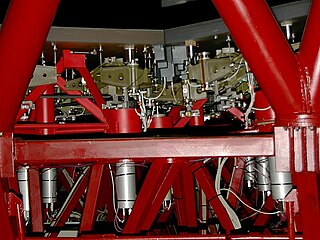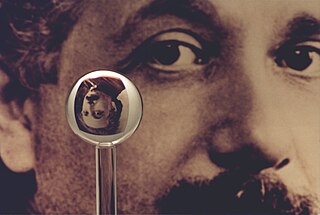
Active optics is a technology used with reflecting telescopes developed in the 1980s, which actively shapes a telescope's mirrors to prevent deformation due to external influences such as wind, temperature, mechanical stress. Without active optics, the construction of 8 metre class telescopes is not possible, nor would telescopes with segmented mirrors be feasible.

Adaptive optics (AO) is a technology used to improve the performance of optical systems by reducing the effect of incoming wavefront distortions by deforming a mirror in order to compensate for the distortion. It is used in astronomical telescopes and laser communication systems to remove the effects of atmospheric distortion, in microscopy, optical fabrication and in retinal imaging systems to reduce optical aberrations. Adaptive optics works by measuring the distortions in a wavefront and compensating for them with a device that corrects those errors such as a deformable mirror or a liquid crystal array.

Astronomical seeing refers to the amount of apparent blurring and twinkling of astronomical objects like stars due to turbulent mixing in the atmosphere of Earth, causing variations of the optical refractive index. The seeing conditions on a given night at a given location describe how much Earth's atmosphere perturbs the images of stars as seen through a telescope.

Fused quartz,fused silica or quartz glass is glass consisting of silica in amorphous (non-crystalline) form. It differs from traditional glasses in containing no other ingredients, which are typically added to glass to lower the melt temperature. Fused silica, therefore, has high working and melting temperatures. Although the terms fused quartz and fused silica are used interchangeably, the optical and thermal properties of fused silica are superior to those of fused quartz and other types of glass due to its purity. For these reasons, it finds use in situations such as semiconductor fabrication and laboratory equipment. It transmits ultraviolet better than other glasses, so is used to make lenses and optics for the ultraviolet spectrum. The low coefficient of thermal expansion of fused quartz makes it a useful material for precision mirror substrates.

In mathematics, the Zernike polynomials are a sequence of polynomials that are orthogonal on the unit disk. Named after optical physicist Frits Zernike, winner of the 1953 Nobel Prize in Physics and the inventor of phase-contrast microscopy, they play important roles in various optics branches such as beam optics and imaging.
Nonimaging optics is the branch of optics concerned with the optimal transfer of light radiation between a source and a target. Unlike traditional imaging optics, the techniques involved do not attempt to form an image of the source; instead an optimized optical system for optimal radiative transfer from a source to a target is desired.

An aspheric lens or asphere is a lens whose surface profiles are not portions of a sphere or cylinder. In photography, a lens assembly that includes an aspheric element is often called an aspherical lens.

An optical fiber is a flexible, transparent fiber made by drawing glass (silica) or plastic to a diameter slightly thicker than that of a human hair. Optical fibers are used most often as a means to transmit light between the two ends of the fiber and find wide usage in fiber-optic communications, where they permit transmission over longer distances and at higher bandwidths than electrical cables. Fibers are used instead of metal wires because signals travel along them with less loss; in addition, fibers are immune to electromagnetic interference, a problem from which metal wires suffer. Fibers are also used for illumination and imaging, and are often wrapped in bundles so they may be used to carry light into, or images out of confined spaces, as in the case of a fiberscope. Specially designed fibers are also used for a variety of other applications, some of them being fiber optic sensors and fiber lasers.
In optics, tilt is a deviation in the direction a beam of light propagates.

Deformable mirrors (DM) are mirrors whose surface can be deformed, in order to achieve wavefront control and correction of optical aberrations. Deformable mirrors are used in combination with wavefront sensors and real-time control systems in adaptive optics. In 2006 they found a new use in femtosecond pulse shaping.

Athermalization, in the field of optics, is the process of achieving optothermal stability in optomechanical systems. This is done by minimizing variations in optical performance over a range of temperatures.

Zerodur, a registered trademark of Schott AG, is a lithium-aluminosilicate glass-ceramic produced by Schott AG since 1968. It has been used for a number of very large telescope mirrors including GTC, Keck I, Keck II, and SOFIA, as well as some smaller telescopes. With its very low coefficient of thermal expansion it can be used to produce mirrors that retain acceptable figures in extremely cold environments such as deep space. Although it has advantages for applications requiring a coefficient of thermal expansion less than that of borosilicate glass, it remains very expensive as compared to borosilicate. The tight tolerance on CTE, ±0.007×10−6 K−1, allows for its use in high-precision applications.
Optics Software for Layout and Optimization (OSLO) is an optical design program originally developed at the University of Rochester in the 1970s. The first commercial version was produced in 1976 by Sinclair Optics. Since then, OSLO has been rewritten several times as computer technology has advanced. In 1993, Sinclair Optics acquired the GENII program for optical design, and many of the features of GENII are now included in OSLO. Lambda Research Corporation purchased the program from Sinclair Optics in 2001.
A common-path interferometer is a class of interferometers in which the reference beam and sample beams travel along the same path. Examples include the Sagnac interferometer, Zernike phase-contrast interferometer, and the point diffraction interferometer. A common-path interferometer is generally more robust to environmental vibrations than a "double-path interferometer" such as the Michelson interferometer or the Mach–Zehnder interferometer. Although travelling along the same path, the reference and sample beams may travel along opposite directions, or they may travel along the same direction but with the same or different polarization.
The eye, like any other optical system, suffers from a number of specific optical aberrations. The optical quality of the eye is limited by optical aberrations, diffraction and scatter. Correction of spherocylindrical refractive errors has been possible for nearly two centuries following Airy's development of methods to measure and correct ocular astigmatism. It has only recently become possible to measure the aberrations of the eye and with the advent of refractive surgery it might be possible to correct certain types of irregular astigmatism.

The NIRSpec is one of the four scientific instruments which will be flown on the James Webb Space Telescope (JWST). The JWST is the follow-on mission to the Hubble Space Telescope (HST) and is developed to receive more information about the origins of the universe by observing infrared light from the first stars and galaxies. In comparison to HST, its instruments will allow looking further back in time and will study the so-called Dark Ages during which the universe was opaque, about 150 to 800 million years after the Big Bang.
Iris AO, Inc. manufactures small-scale, microelectromechanical systems (MEMS)-based deformable mirrors (DM) and adaptive optics systems that offer radical advantages in cost, size, durability, flexibility, and power consumption. Iris AO systems make adaptive optics (AO) practical for a host of new applications, including astronomy, retinal and biomedical imaging, beam shaping, portable laser communications, and horizontal-path imaging.

ATS-2 was a communications satellite launched by NASA on April 6, 1967 on an Atlas-Agena D rocket from Cape Canaveral.

Optical Telescope Element (OTE) is a sub-section of the James Webb Space Telescope, a large infrared space telescope scheduled to be launched early 2021. The OTE consists of some major parts of the telescopes including the main mirror, the secondary mirrors, the framework and controls to support those mirrors, and various thermal and other systems to support the functioning of the telescope. The other two major sections of the JWST are the Integrated Science Instrument Module (ISIM) and the Spacecraft Element (SE), which includes the Spacecraft Bus and Sunshield. The OTE collects the light and sends it to the science instruments in the ISIM. The OTE has been compared to being the "eye" of the telescope and the backplane of it to being the "spine".

The OTE Pathfinder, or JWST Pathfinder, is a technology demonstrator/test article for the James Webb Space Telescope. It is a non-flight replica of the actual backplane, but only includes the center section not the two "Wings" on the side the extend and have additional segments on the actual JWST. It has been used for various tests and has some different configurations, but some of the major tests have been practicing installing mirror segments with non-flight hardware as well as thermal tests. The Pathfinder has also been tested in conjunction with flight hardware including the Aft Optics System. One of the goals and uses of the pathfinder is risk reduction for JWST program. The pathfinder allows practicing integration and testing procedures, and for risk mitigation With the Pathfinder it was possible to test phasing two mirrors together and also to do tests with the Aft Optical System. The OTE Pathfinder was part of the plan for integration and testing of JWST, and in particular supported the Optical Telescope Element.















